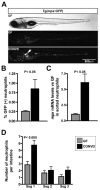Commensal microbiota stimulate systemic neutrophil migration through induction of serum amyloid A
- PMID: 24373309
- PMCID: PMC4364439
- DOI: 10.1111/cmi.12257
Commensal microbiota stimulate systemic neutrophil migration through induction of serum amyloid A
Abstract
Neutrophils serve critical roles in inflammatory responses to infection and injury, and mechanisms governing their activity represent attractive targets for controlling inflammation. The commensal microbiota is known to regulate the activity of neutrophils and other leucocytes in the intestine, but the systemic impact of the microbiota on neutrophils remains unknown. Here we utilized in vivo imaging in gnotobiotic zebrafish to reveal diverse effects of microbiota colonization on systemic neutrophil development and function. The presence of a microbiota resulted in increased neutrophil number and myeloperoxidase expression, and altered neutrophil localization and migratory behaviours. These effects of the microbiota on neutrophil homeostasis were accompanied by an increased recruitment of neutrophils to injury. Genetic analysis identified the microbiota-induced acute phase protein serum amyloid A (Saa) as a host factor mediating microbial stimulation of tissue-specific neutrophil migratory behaviours. In vitro studies revealed that zebrafish cells respond to Saa exposure by activating NF-κB, and that Saa-dependent neutrophil migration requires NF-κB-dependent gene expression. These results implicate the commensal microbiota as an important environmental factor regulating diverse aspects of systemic neutrophil development and function, and reveal a critical role for a Saa-NF-κB signalling axis in mediating neutrophil migratory responses.
© 2013 John Wiley & Sons Ltd.
Figures






References
-
- Baranova IN, Vishnyakova TG, Bocharov AV, Kurlander R, Chen Z, Kimelman ML, et al. Serum amyloid A binding to CLA-1 (CD36 and LIMPII analogous-1) mediates serum amyloid A protein-induced activation of ERK1/2 and p38 mitogen-activated protein kinases. J Biol Chem. 2005;280:8031–8040. - PubMed
Publication types
MeSH terms
Substances
Grants and funding
- R01 DK073338/DK/NIDDK NIH HHS/United States
- P01 DK094779/DK/NIDDK NIH HHS/United States
- R01 DK047700/DK/NIDDK NIH HHS/United States
- DK073338/DK/NIDDK NIH HHS/United States
- P30 DK034987/DK/NIDDK NIH HHS/United States
- R01 DK081426/DK/NIDDK NIH HHS/United States
- DK081426/DK/NIDDK NIH HHS/United States
- R56 DK047700/DK/NIDDK NIH HHS/United States
- DK094779/DK/NIDDK NIH HHS/United States
- K01 DK073695/DK/NIDDK NIH HHS/United States
- DK073695/DK/NIDDK NIH HHS/United States
- DK034987/DK/NIDDK NIH HHS/United States
- DK047700/DK/NIDDK NIH HHS/United States
LinkOut - more resources
Full Text Sources
Other Literature Sources
Molecular Biology Databases
Research Materials

